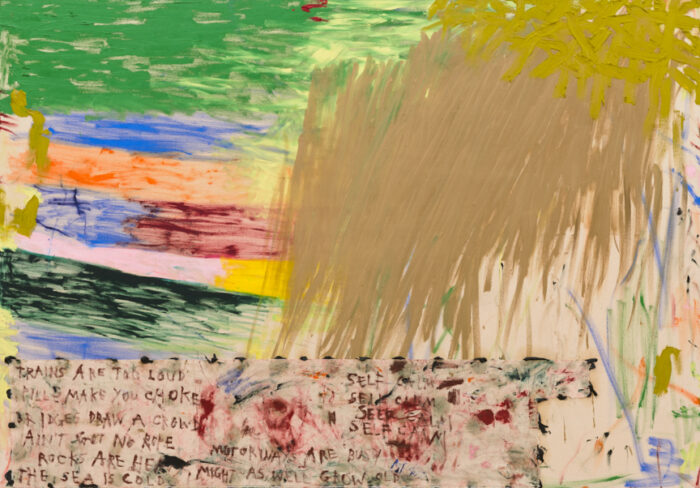
symbiopsychotaxiplasm at Nicodim Gallery
March 10 – April 14, 2022
All images courtesy of Nicodim Gallery
Participating artists: Aviva Silverman, Astrid Terrazas, Daisy Parris, Devin N Morris, Drake Carr, Marisa Takal, Frieda Toranzo Jaeger, Jesse Morsberger, Mosie Romney, Michelle Uckotter, Willie Jinks, and Mose Tolliver.
The title of the 12-person group show “Symbiopsychotaxiplasm” is based on a 1971 documentary film of the same name by African-American filmmaker William Greaves. In that film, he studies the nature of things by constantly suggesting random occurrences and even the filming of filming. In this show, curator Mosie Romney seeks to illustrate the disparate, random, and erotic nature of experience. Its delivery of chance, behind which a design may, or may not, exist, can be found in the highly various works of art on exhibition. In a show offering works so very different from each other, the viewer has to make an effort to place the imagery under a single interpretation. In this case, the variety itself may be the point of interest, much as experience in life can appear to be so happenstance and unrelated as to defy cohesion. We have so many artists now working in New York, in so many different ways, we can only point out the myriad styles and use eclecticism as the major explanation. Romney’s choice of artists may not seem to be contained within a general metaphor; instead, he chooses to convey the disconnect many of us feel today in both art and personal relations. So the metaphor underlying the exhibition has more to do with a certain kind of happenstance, suggested in Greaves’s movie, in which chance becomes the device by which the theme is suggested.

The audience can see this immediately, in the large toy train set up about four feet high, supported by white wooden pillars, that dominate the center of the gallery. The train, rather long, travels along an intersecting track. Avivah Silverman made this piece, called Queen City Special (2020). Several of the individual cars have small, cartoon-like figures on them; the atmosphere generated by the miniature figures traveling on an oversize track is circus-like; a cartoon-like vulgarity prevails. One is hard-pressed to generate an overarching theme from the piece, beyond its playful identification with a populist outlook. The train simply motors along, challenging its audience to make sense of its democratic ethos. Michelle Uckotter’s Confession Booth (2022), a pastel on paper, shows two doors open to two rooms: one with a seat for the priest to hear the person; and the other, separated from the first by a wood-framed confessional grill, for the penitent to recite sins. The doors are painted dark green, the floors are a dark brown, and the walls are a darkish white. Competently rendered, the scene has somber overtones, so that a sense of foreboding, in keeping with the activity of confession, takes over the painting’s atmosphere.


Jesse Morseberger’s Welcome to Station Square (2021) shows a hedgehog standing on the top of a skyscraper. Painted in black, with a mostly blue outline, the figure’s headdress spills out behind him. Small, ovals of yellow decorate the sides of the pedestal on which the figure stands; beyond this sight, in most of the middle of the painting, we see an urban density, an array of buildings mostly outlined in green. Above, a bright blue sky with clouds finishes the composition. We are not sure whether the site belongs to Forest Hills, Queens, or Pittsburgh—both places have areas given this name. Instead, the painting becomes a homage to the pulsing attractiveness of urban life at night. Curator Romney’s assertive painting called The Undertitty (2022) shows a young black man with wide-open eyes and an open mouth displaying teeth; to his left are two sets of pink umbrellas. Painted directly on his bare chest are two similar figures: undressed women in a reclining position, their arms underneath their heads. They are given a yellow torso, brown legs, and shoes. Romney is describing the power of fantasy and the influence of eroticism. He pays homage to desire as a general theme. It is a scenario of concupiscence, embellished by odd artifacts decorating the scene.


Daisy Paris’s abstraction, Might As Well Grow Old (After Dorothy Parker) (2021) is a painting composed of deliberate disorder: on the upper right, an unboundaried brown mass with thick drips at the bottom occurs; on the upper left, an extended width of green takes place, while beneath it are stripes of differing colors—blue, orange, red, pink. At the bottom of the composition, writing is found, most legible on the left. Dorothy Parker was a noted 20th-century American poet and wit, known for her sardonic style. Paris’s work feels like a homage to Parker’s spirit, in abstract terms. Lastly, Drake Carr’s figurative painting Tara (2019) shows a black woman with short hair and closed fists, wearing a green tube top revealing her midriff. Her shorts are blue. Painted with bent knees, the figure’s outline determines the shape of the painting. She is smiling, with her hands assuming something like a martial arts position. The work celebrates the energy and confidence of youth in a particularly attractive manner. “Symbiopscychotaxiplasm” asserts the vigor of artists relatively new to the scene, in a way that requires attention. Romney may have chosen his artists for their willingness to portray new social realities; a good number of the paintings are realistic, perhaps because current social exchanges need to be accurately described. The results are challenging and memorable.



